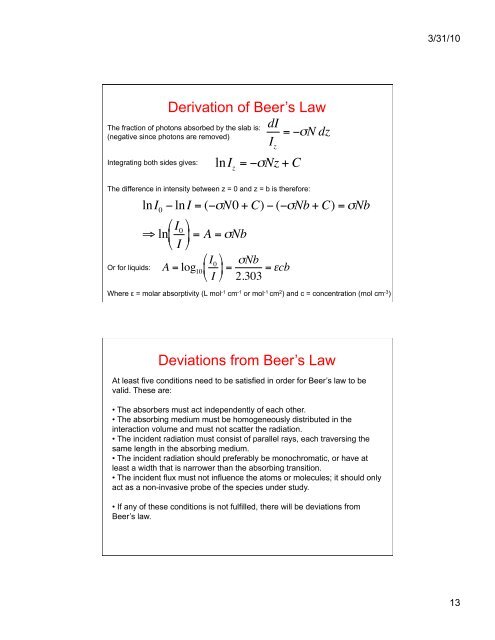Atmospheric Transmission Beer's Law
Atmospheric Transmission Beer's Law
Atmospheric Transmission Beer's Law
Create successful ePaper yourself
Turn your PDF publications into a flip-book with our unique Google optimized e-Paper software.
3/31/10The fraction of photons absorbed by the slab is:(negative since photons are removed)Integrating both sides gives:Derivation of Beer’s <strong>Law</strong>dI= −σN dzI zlnI z= −σNz + CThe difference in intensity between z = 0 and z = b is therefore:Or for liquids:lnI€0− ln I = (−σN0 + C) − (−σNb + C) = σNb€ ⎛⎛⇒ ln I ⎞⎞0⎜⎜ ⎟⎟ = A = σNb⎝⎝ I ⎠⎠⎛⎛ IA = log 0⎞⎞10 ⎜⎜ ⎟⎟ = σNb⎝⎝ I ⎠⎠ 2.303 = εcb€Where ε = molar absorptivity (L mol -1 cm -1 or mol -1 cm 2 ) and c = concentration (mol cm -3 )€Deviations from Beer’s <strong>Law</strong>At least five conditions need to be satisfied in order for Beer’s law to bevalid. These are:• The absorbers must act independently of each other.• The absorbing medium must be homogeneously distributed in theinteraction volume and must not scatter the radiation.• The incident radiation must consist of parallel rays, each traversing thesame length in the absorbing medium.• The incident radiation should preferably be monochromatic, or have atleast a width that is narrower than the absorbing transition.• The incident flux must not influence the atoms or molecules; it should onlyact as a non-invasive probe of the species under study.• If any of these conditions is not fulfilled, there will be deviations fromBeer’s law.13
















